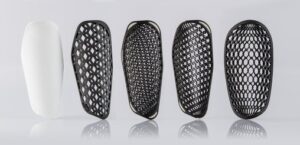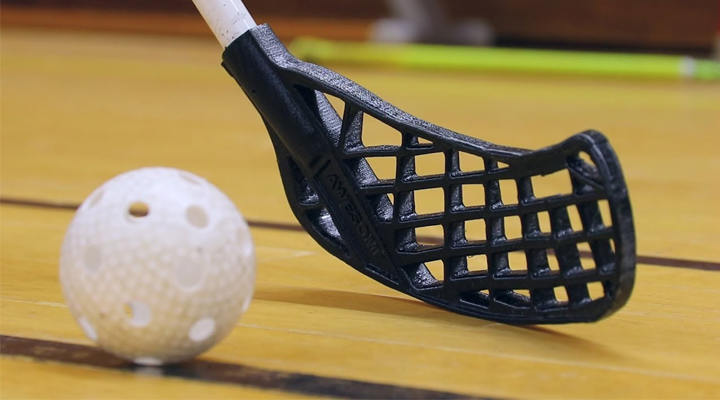3D printing has emerged as a key technology in the world of sports, providing new opportunities for the design and production of equipment and performance monitoring. From custom-fit helmets to 3D-printed shoes, 3D printing is transforming the way athletes train and compete. In this article, we will explore the use of 3D printing in sports, including advancements in equipment and performance monitoring.
Advancements in Equipment
One of the key benefits of 3D printing in sports is the ability to create custom-fit equipment that is tailored to the specific needs of the athlete. Here are some of the key advancements in equipment design and production using 3D printing:
Helmets
3D printing allows for the creation of custom-fit helmets that are designed to fit the unique shape of an athlete’s head. This can improve comfort and reduce the risk of injury, particularly in contact sports such as football and hockey.
Shoes
3D printing can also be used to create custom-fit shoes that are tailored to the athlete’s foot shape and running style. This can improve comfort and reduce the risk of injury, particularly in sports that involve a lot of running, such as track and field.

Prosthetics
3D printing can be used to create custom prosthetics that are tailored to the specific needs of the athlete. This can improve mobility and performance, particularly for athletes with disabilities.
Sports Equipment
3D printing can also be used to create custom sports equipment, such as rackets and paddles, that are tailored to the athlete’s playing style and preferences. This can improve performance and reduce the risk of injury.
Advancements in Performance Monitoring
In addition to advancements in equipment design and production, 3D printing has also been used to create new opportunities for performance monitoring in sports. Here are some of the key advancements:

Wearable Sensors: 3D printing allows for the creation of custom-fit wearable sensors that can monitor an athlete’s movement and performance. This can provide valuable data on factors such as speed, acceleration, and impact force, which can be used to improve training and reduce the risk of injury.
Biomechanical Analysis: 3D printing can be used to create custom biomechanical models of athletes, which can help coaches and trainers analyze an athlete’s movement and identify areas for improvement. This can lead to more targeted and effective training programs.
Customized Training Equipment: 3D printing can also be used to create customized training equipment that is tailored to the athlete’s needs and goals. This can improve training effectiveness and reduce the risk of injury.
Challenges and Considerations
While 3D printing offers many benefits in the world of sports, there are also challenges and considerations to keep in mind. Here are some of the key challenges:
Cost: The cost of 3D printing technology can be high, particularly for large-scale projects. This can make it difficult for some teams and athletes to adopt 3D printing as a key technology in their training and equipment needs.
Quality Control: The quality of 3D printed equipment can vary depending on the quality of the printer and the materials used. This can make it difficult to ensure consistent quality across different productions.
Regulations: There are regulations in place in some sports, particularly contact sports such as football and hockey, that require equipment to meet specific safety standards. This can make it difficult to adopt 3D printing in the production of equipment, particularly for professional athletes.
Future Trends in 3D Printing and Sports
As 3D printing and sports continue to evolve, there are several future trends that are emerging in the industry. Here are some of the key trends to watch:
Integration with Artificial Intelligence
The integration of 3D printing with artificial intelligence (AI) is a growing trend in the industry. By incorporating AI technology, 3D printing can become more autonomous, making decisions and adapting to changing environments in real-time.
Use of Advanced Materials
The use of advanced materials in 3D printing is a growing trend, particularly in the production of sports equipment. By using innovative materials, such as carbon fiber and bioplastics, designers and engineers can create equipment that is more durable, sustainable, and efficient.
Expansion of Additive Manufacturing
The expansion of additive manufacturing, which includes 3D printing and other technologies, is a growing trend in the production of sports equipment. Additive manufacturing allows for the rapid production of custom components and structures, reducing the time and cost of production.
Customization and Personalization
The trend towards customization and personalization is also growing in the production of sports equipment. By using 3D printing to create custom-fit equipment, designers and engineers can create equipment that is tailored to the specific needs of the athlete.

As the technology continues to evolve, there are several future trends that are emerging in the industry. The integration of 3D printing with artificial intelligence (AI) is a growing trend in the industry. By incorporating AI technology, 3D printing can become more autonomous, making decisions and adapting to changing environments in real-time. The use of advanced materials in 3D printing is also a growing trend, particularly in the production of sports equipment. By using innovative materials, designers and engineers can create equipment that is more durable, sustainable, and efficient.
Another growing trend is the expansion of additive manufacturing, which includes 3D printing and other technologies. Additive manufacturing allows for the rapid production of custom components and structures, reducing the time and cost of production. Finally, the trend towards customization and personalization is also growing in the production of sports equipment. By using 3D printing to create custom-fit equipment, designers and engineers can create equipment that is tailored to the specific needs of the athlete.
While 3D printing offers many benefits in the world of sports, there are also challenges and considerations to keep in mind. The cost of 3D printing technology can be high, particularly for large-scale projects. This can make it difficult for some teams and athletes to adopt 3D printing as a key technology in their training and equipment needs.
The quality of 3D printed equipment can vary depending on the quality of the printer and the materials used. This can make it difficult to ensure consistent quality across different productions. There are also regulations in place in some sports, particularly contact sports such as football and hockey, that require equipment to meet specific safety standards. This can make it difficult to adopt 3D printing in the production of equipment, particularly for professional athletes.
Conclusion
The use of 3D printing in sports is a rapidly growing trend, providing new opportunities for the design and production of equipment and performance monitoring. The use of 3D printing allows for greater customization, speed, efficiency, and design flexibility in the production of sports equipment and performance monitoring.
As the technology continues to evolve, we can expect to see even more innovation and growth in the use of 3D printing in sports. With careful planning and consideration, 3D printing can be a valuable tool in the creation of innovative and effective equipment and training programs for athletes. The future possibilities are endless, and we can expect to see even more advancements and applications of 3D printing in the world of sports.





